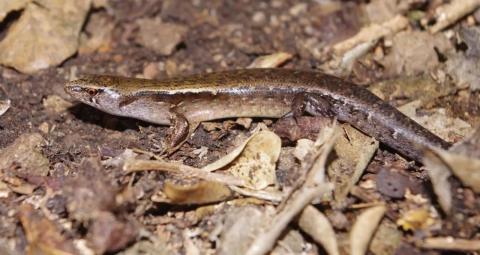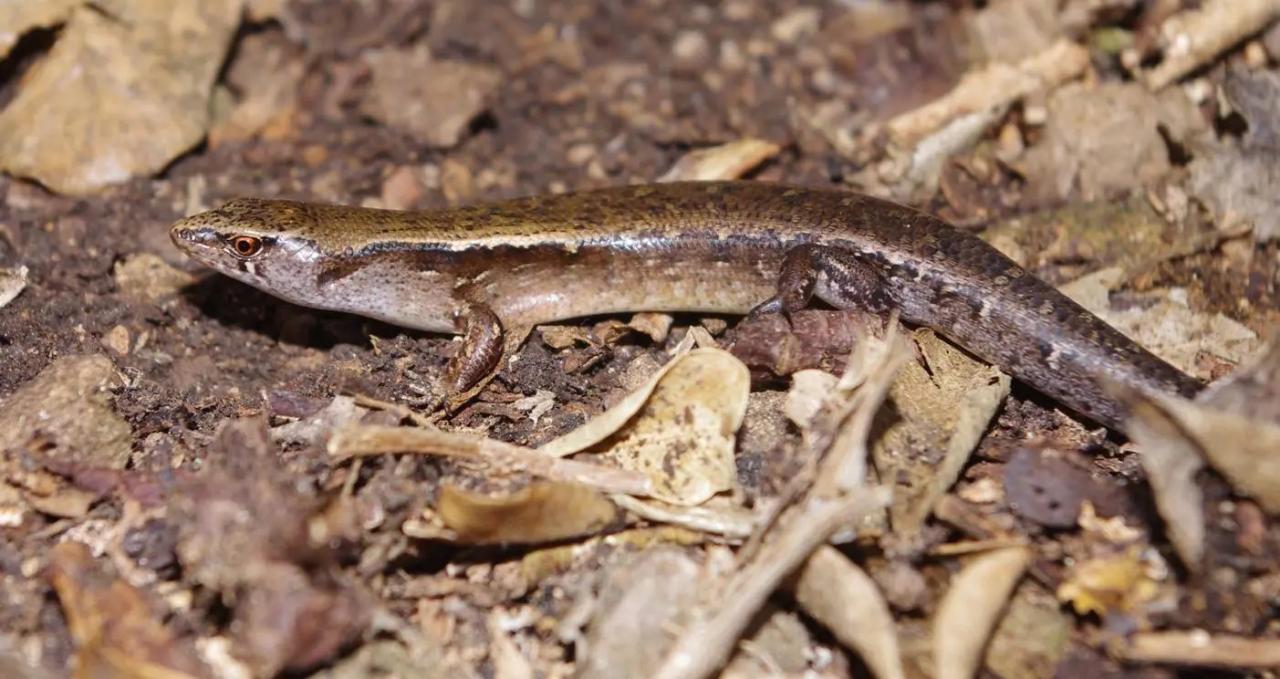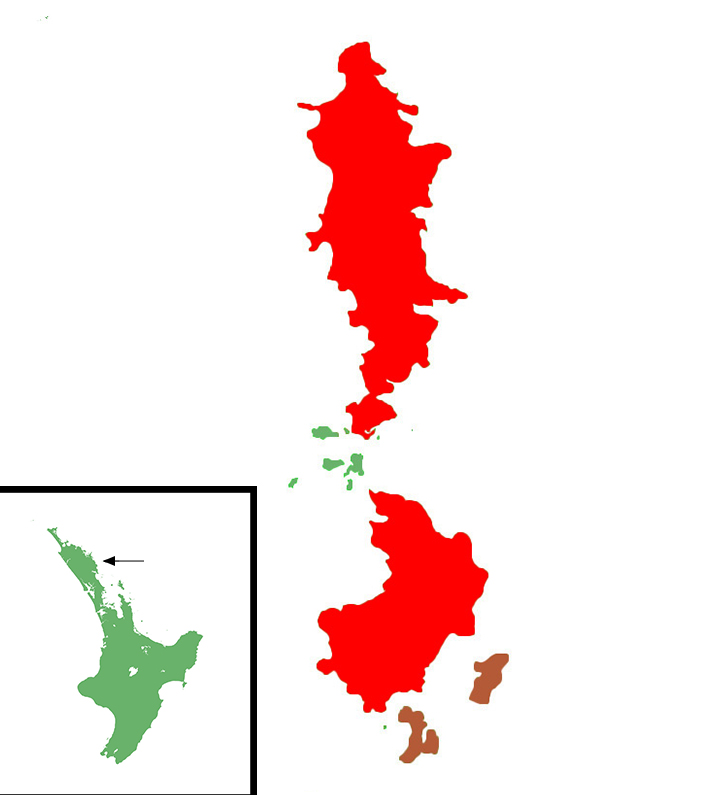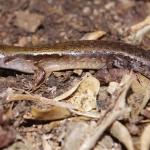- Home
- Herpetofauna Index
- Native
- Oligosoma Roimata
Oligosoma roimata
Aorangi skink
Oligosoma roimata
(Patterson et al., 2013)

Length: SVL up to 65mm, with the tail being equal to or shorter than the body length
Weight: unknown
Description
Aorangi skinks are an island-endemic relative of the ornate skink (Oligosoma ornatum), and descended from common ancestors of the two species which became isolated on the Poor Knights Islands.
Similar in appearance to ornate skinks but with a more pointed snout, and pale-coloured (versus usually yellow or salmon-coloured) belly. Head often has black speckling on top, and a prominent tear-drop marking below the eye. Dorsal surfaces are brown or grey-brown, with or without lighter and darker speckling. Dorsolateral stripes are pale-brown or copper, bordered below by a black marking / stripe which extends slightly onto the flanks and may have a jagged edge. Lateral surfaces are a lighter grey-brown and either uniform or with lighter spots which are often outlined in dark-grey or black. Ventral surfaces are white or cream and lightly speckled. Can be distinguished from the syntopic Hardy's skink (Oligosoma hardyi) by the presence of a pale dark-edged tear-drop marking below the eye (versus denticulate patterning along the mouth on Hardy's skinks).
Life expectancy
Unknown.
Distribution
Endemic to the Poor Knights Islands off Northland. Found only on the two largest islands in the Poor Knights group (Aorangi and Tawhiti Rahi).
Ecology and habitat
Little is known about the ecology of Aorangi skinks. They are either cathemeral (active day or night when conditions are favourable) or crepuscular. Aorangi skinks are a cryptic species, but have been known to bask near cover / refuge sites.
They occupy areas of coastal forest either on the edge or forest interior. When not actively foraging they take refuge in dense low vegetation, or under rocks and logs. They can be found near colonies of burrowing seabirds and may take refuge in the burrows.
Social structure
Solitary.
Breeding biology
Unknown, but likely similar to the closely related ornate skink (Oligosoma ornatum).
Diet
Aorangi skinks are known to feed on small invertebrates (insects, crustaceans etc.)
Disease
Unknown.
Conservation strategy
The Poor Knights islands have been pest-free since 1936 when feral pigs were eradicated. Because Aorangi skinks only occur on pest-free islands, and occupy the entire extent of their historical range, no specific conservation action is required other than maintaining biosecurity to keep the islands pest-free.
Interesting notes
The Poor Knights Islands are an area of high endemism. Many lizards on the Poor Knights islands are closely related to species which occur on the mainland, and are descended from common ancestors which became isolated when the islands separated from the North Island mainland around 2 million years ago. The Aorangi skink diverged from ornate skink (Oligosoma ornatum) common ancestors, other examples include Hardy's skink (O. hardyi) - which diverged from copper skink (O. aeneum) common ancestors, and the Poor Knights gecko (Dactylocnemis "Poor Knights") which diverged from Pacific gecko (D. pacificus) common ancestors.
The Aorangi skink, along with its sister taxa (the ornate skink) sit within clade 4 (the teardrop skink complex) of the Oligosoma genus, being sister to the rest of the ornate skink complex (e.g. marbled, Whitaker's, Hauraki skink etc.). The Falla's skink, robust skink and Mcgregor's skink are also members of this clade but diverged much earlier.
References
Hitchmough, R.A., Barr, B., Lettink, M., Monks, J., Reardon, J., Tocher, M., van Winkel, D., Rolfe, J. (2016). Conservation status of New Zealand reptiles, 2015; New Zealand threat classification series 17. Wellington: New Zealand Department of Conservation.
Jewell, T. (2011). A photographic guide to reptiles and amphibians of New Zealand. Auckland: New Holland Publishing.
van Winkel, D., Baling, M. & Hitchmough, R. (2018). Reptiles and Amphibians of New Zealand: A field guide. Auckland: Auckland University Press, 376 pp.
Whitaker, A. H. (1968). The lizards of the Poor Knights Islands, New Zealand. New Zealand journal of science, 11, 623-651.

Aorangi skink (Aorangi Island, Poor Knights). © Colin Miskelly: Sourced from Te Papa Blogs


